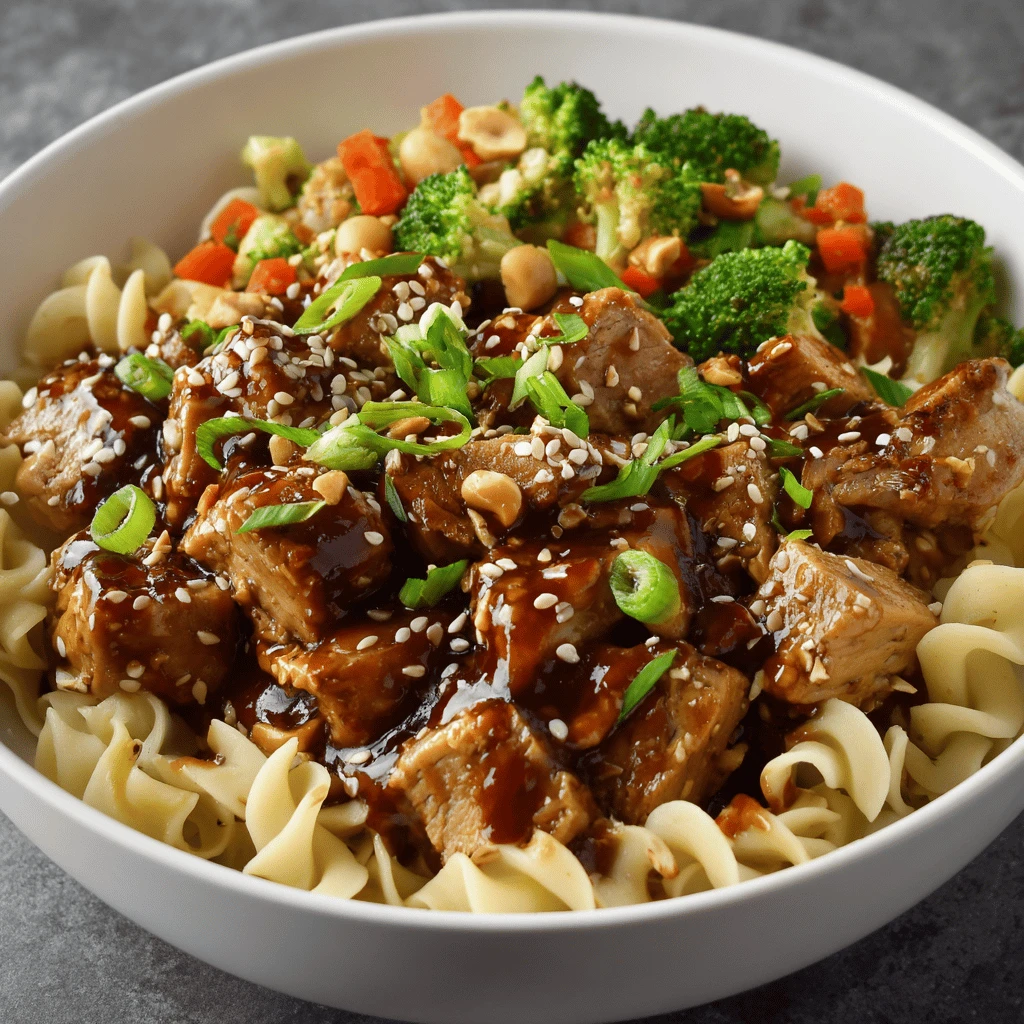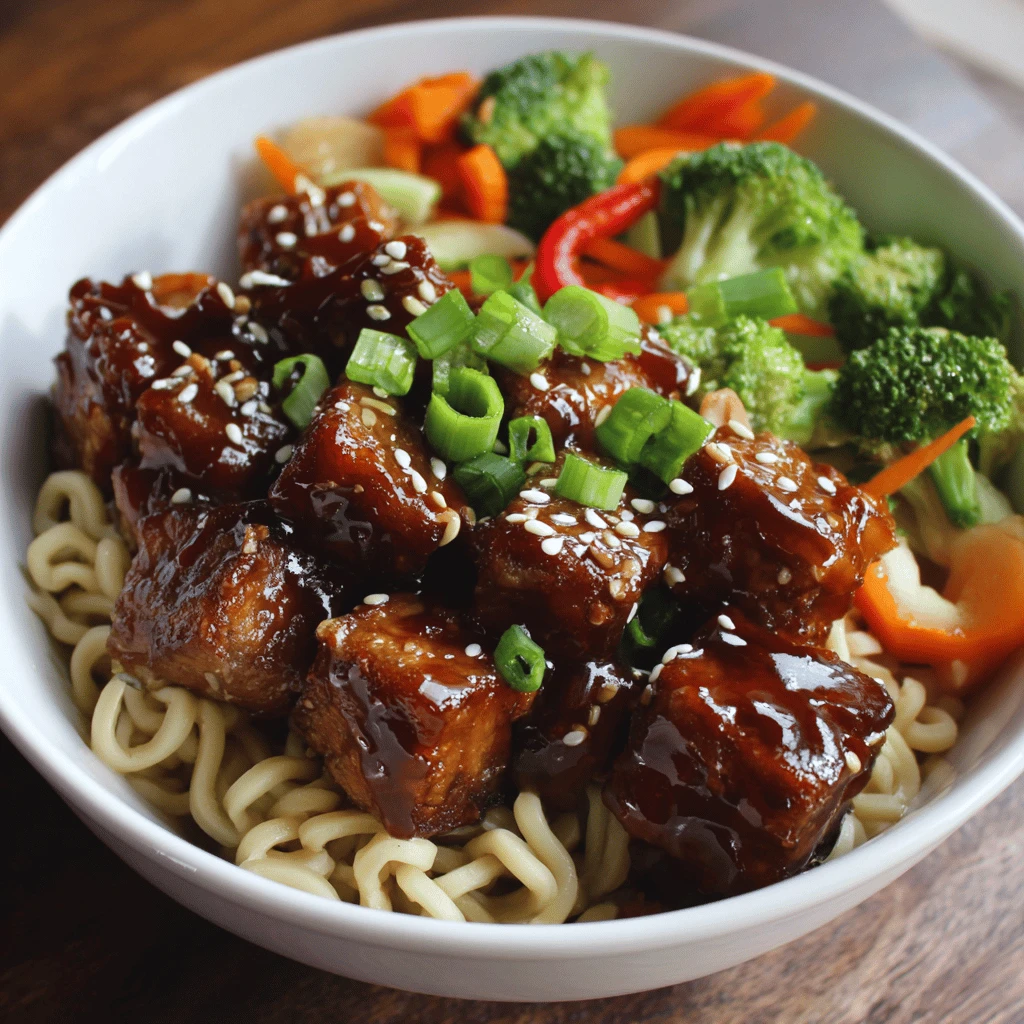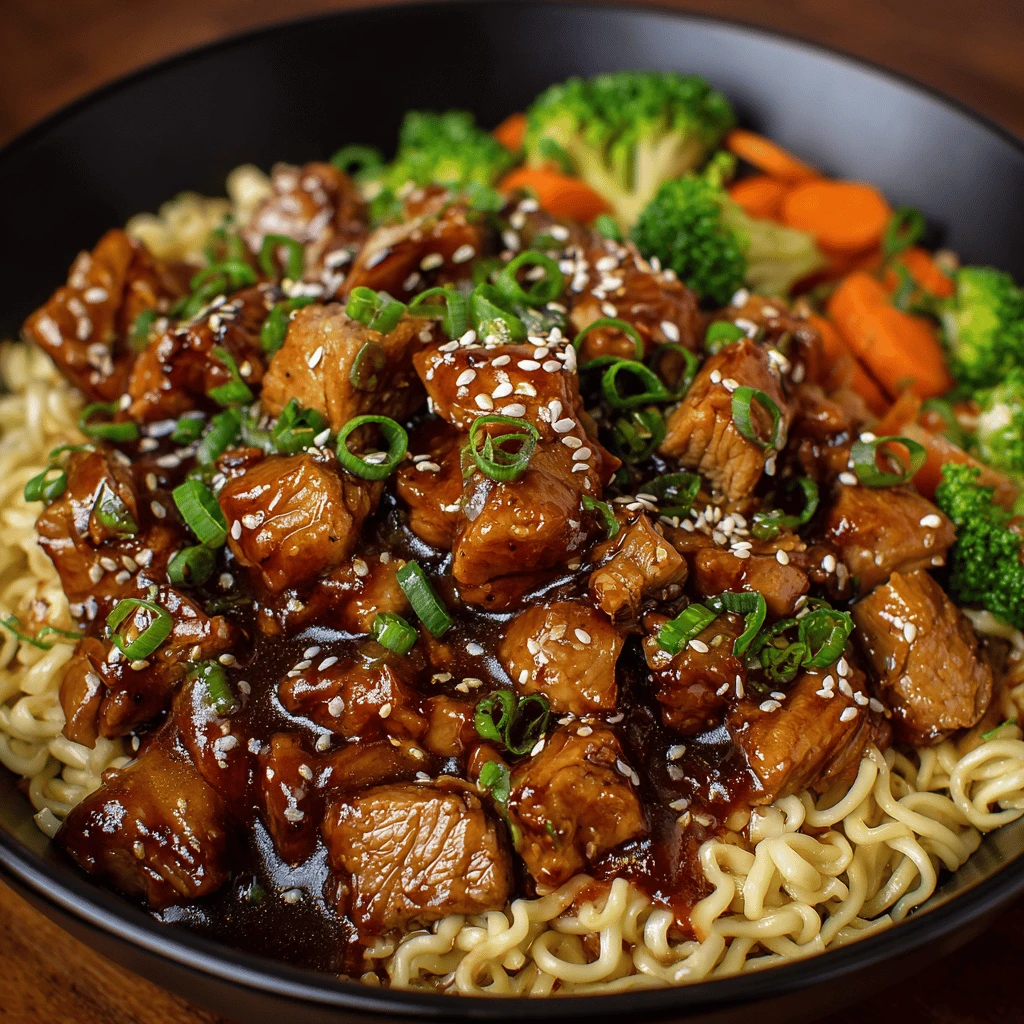Crockpot Teriyaki torso Noodle Bowls
Ingredients
- 1. 5 lbs boneless, skinless torso (chicken, turkey, or plant-based alternative), cut into 1-inch cubes
- 1 cup teriyaki sauce (store-bought or homemade)
- 1/2 cup chicken broth (or vegetable broth)
- 1/4 cup brown sugar (packed)
- 2 tablespoons soy sauce (low sodium preferred)
- 1 tablespoon rice vinegar
- 1 teaspoon ground ginger
- 1/2 teaspoon garlic powder
- 1/4 teaspoon red pepper flakes (optional, for heat)
- 8 ounces dried egg noodles (or udon, ramen, or gluten-free alternative)
- 2 cups frozen mixed vegetables (broccoli, carrots, peas, etc.)
- 2 green onions, thinly sliced (for garnish)
- 1 tablespoon sesame seeds (for garnish)
- Optional toppings: Sriracha, chopped peanuts, cilantro
Step-by-Step
1. Place the torso cubes in the bottom of a 6-quart or larger slow cooker.
2. In a medium bowl, whisk together the teriyaki sauce, chicken broth, brown sugar, soy sauce, rice vinegar, ground ginger, garlic powder, and red pepper flakes (if using).
3. Pour the sauce mixture over the torso in the slow cooker, ensuring that all the pieces are evenly coated.
4. Cover the slow cooker and cook on low for 6-8 hours, or on high for 3-4 hours, or until the torso is cooked through and easily shreds with a fork.
5. About 30 minutes before serving, cook the noodles according to package directions. Drain well.
6. Stir the cooked noodles and frozen mixed vegetables into the slow cooker with the teriyaki torso.
7. Cover and cook for another 10-15 minutes, or until the vegetables are heated through and the noodles are warmed.
8. Serve the teriyaki torso noodle bowls hot, garnished with sliced green onions and sesame seeds.
9. Optional toppings include Sriracha for heat, chopped peanuts for crunch, and fresh cilantro for flavor.
10. Enjoy!
Understanding the Ingredients
H3: Choosing Your Torso
The key to a great torso noodle bowl starts with the “torso” itself. While this recipe is adaptable to different protein sources, the cooking time may need adjusting based on your selection.
Chicken torso is a classic choice, offering a tender and flavorful option that absorbs the teriyaki sauce beautifully.
Turkey torso provides a leaner alternative with a similar texture to chicken.
For vegetarian or vegan versions, consider using firm tofu, tempeh, or even jackfruit. Remember to adjust cooking times accordingly, as these alternatives may require less time in the slow cooker.
H3: Mastering the Teriyaki Sauce
The teriyaki sauce is the heart and soul of this dish, providing the signature sweet and savory flavor. You have the option of using store-bought teriyaki sauce for convenience or making your own from scratch for a more customized flavor profile.
Store-bought sauces can vary in sweetness and sodium content, so choose one that suits your preferences.
If you opt for a homemade sauce, you can adjust the amount of brown sugar, soy sauce, and other ingredients to achieve your desired taste.
H3: Selecting the Perfect Noodles
The type of noodle you choose can significantly impact the texture and overall experience of your teriyaki torso noodle bowl.
Egg noodles are a popular choice, offering a soft and chewy texture that pairs well with the teriyaki sauce.
Udon noodles provide a thicker and chewier alternative, while ramen noodles offer a slightly firmer texture.
For those with dietary restrictions, gluten-free noodles made from rice flour, corn flour, or other gluten-free ingredients are readily available.
Preparing the Recipe
H3: Optimizing Slow Cooker Performance
Slow cookers are fantastic for hands-off cooking, but there are a few things to keep in mind to ensure optimal results.
Avoid lifting the lid frequently during cooking, as this releases heat and moisture, potentially prolonging the cooking time.
If you’re using a slow cooker with a high heat setting, you may need to reduce the cooking time to prevent the torso from drying out.
H3: Achieving the Perfect Texture
One of the most important aspects of this recipe is achieving the perfect texture for the torso.
You want it to be tender and easily shreddable, but not dry or overcooked.
Monitor the torso during cooking and adjust the cooking time as needed.
H3: Adding Vegetables for Nutrition and Flavor
Including vegetables in your teriyaki torso noodle bowl adds both nutritional value and flavor.
Frozen mixed vegetables are a convenient option, but you can also use fresh vegetables such as broccoli florets, sliced carrots, and snow peas.
If using fresh vegetables, you may want to add them to the slow cooker earlier in the cooking process to ensure they cook through.
Serving Suggestions
H3: Garnish for Visual Appeal and Enhanced Flavor
Garnishes are the final touch that elevates your teriyaki torso noodle bowl from a simple meal to a culinary experience.
Sliced green onions and sesame seeds add visual appeal and a subtle nutty flavor.
Other garnish options include Sriracha for heat, chopped peanuts for crunch, and fresh cilantro for a burst of freshness.
H3: Pairing Suggestions
Consider serving your teriyaki torso noodle bowl with a side of steamed edamame or a fresh cucumber salad.
A light and crisp white wine, such as Sauvignon Blanc or Pinot Grigio, pairs well with the savory and slightly sweet flavors of the dish.
H3: Customizing for Dietary Needs
This recipe can be easily adapted to accommodate various dietary needs and preferences.
For a gluten-free version, use gluten-free noodles and tamari (gluten-free soy sauce).
For a vegetarian or vegan version, substitute the torso with tofu, tempeh, or jackfruit.
Storage and Reheating
H3: Storing Leftovers
Allow the teriyaki torso noodle bowls to cool completely before storing them in an airtight container in the refrigerator.
Leftovers can be stored for up to 3-4 days.
H3: Reheating Instructions
Reheat the teriyaki torso noodle bowls in the microwave or on the stovetop.
If reheating in the microwave, cover the bowl with a microwave-safe lid or plastic wrap to prevent splattering.
If reheating on the stovetop, add a splash of water or broth to the pan to prevent the noodles from drying out.
H3: Freezing Options
While the noodles may become slightly softer after freezing and thawing, teriyaki torso noodle bowls can be frozen for up to 2-3 months.
To freeze, allow the dish to cool completely, then transfer it to a freezer-safe container.
Thaw in the refrigerator overnight before reheating.
Variations and Adaptations
H3: Spicy Teriyaki Torso Noodle Bowls
Add a tablespoon or two of Sriracha or chili garlic sauce to the teriyaki sauce mixture for a spicy kick.
You can also garnish the bowls with red pepper flakes for an extra dose of heat.
H3: Honey Garlic Teriyaki Torso Noodle Bowls
Replace the brown sugar with honey for a slightly different sweetness and flavor profile.
Add a few cloves of minced garlic to the sauce for an extra layer of flavor.
H3: Pineapple Teriyaki Torso Noodle Bowls
Add diced pineapple to the slow cooker for a tropical twist.
The pineapple will add sweetness and acidity to the dish, complementing the savory teriyaki sauce.
FAQ
H3: Can I use different types of noodles?
Yes, you can use any type of noodle you prefer, such as udon, ramen, or soba noodles. Cooking times may vary, so adjust accordingly.
H3: Can I add more vegetables?
Absolutely! Feel free to add any vegetables you like, such as bell peppers, mushrooms, or snap peas.
H3: Can I make this in an Instant Pot?
Yes, you can adapt this recipe for the Instant Pot. Reduce the cooking time significantly, typically to about 10-15 minutes on high pressure, followed by a natural pressure release.
H3: Can I make this ahead of time?
Yes, you can prepare the teriyaki torso in the slow cooker ahead of time and store it in the refrigerator. Cook the noodles separately just before serving.
H3: How do I prevent the noodles from getting mushy?
Cook the noodles separately and add them to the slow cooker during the last 15 minutes of cooking time to prevent them from becoming mushy.




